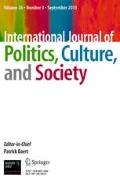Abstract
Focusing on the case of Berlin, this article explores the function of memory landscapes using the concept of the labor of the negative. Through three Berlin cases—the memorialization of the Berlin Wall, recent counter-memorials to the Holocaust, and the urban appropriation of voids through temporary projects—the article suggests that the labor of the negative constitutes Berlin’s memory landscape out of the interplay between absence and presence.
Similar content being viewed by others
References
Aitchison, M (2011). The Berlin Model BM-00. Tarp architecture manual (Insidious Urbanism) (pp. 97–111).
Arnold-de Simine, S. (2012). Memory museum and museum text: intermediality in Daniel Libeskind’s Jewish museum and W.G. Sebald’s Austerlitz. Theory, Culture & Society, 29(1), 14–35.
Bader, M., et al. (2011). IBA Berlin 2020 Konzept: Stadt Kapital! Hauptstadt, Raumstadt, Sofortstadt. Berlin: Senatsverwaltung fuer Stadtentwicklung.
Beekmans, J. (2009). Klaus Overmeyer on the importance of urban pioneers. The pop up city. http://popupcity.net. Accessed 22 April 2012.
Borneman, J. (1998). Subversions of international order: Studies in the political anthropology of culture. Albany: State University of New York Press.
Caruth, C. (1996). Unclaimed experience: Trauma, narrative, and history. Baltimore: Johns Hopkins University Press.
Caspar, H. (2008). Erinnerungsorte in Berlin: Führer zu Schauplätzen deutscher Geschichte. Petersberg: Imhof.
Chakravorty, M. (2004). Hegel-Marx: the “other” logic of unproductive labor. Bad Subjects (p. 66).
Colomb, C. (2012). Staging the New Berlin: Place marketing and the politics of urban reinvention post-1989. New York: Routledge.
Eisenman, P. (2005). Memorial to the murdered Jews of Europe. New York: Leo Baeck Institute.
Engel, J. A. (2009). The fall of the Berlin Wall: The revolutionary legacy Of 1989. Oxford: Oxford University Press.
Fassin, D., & Rechtman, R. (2009). The empire of trauma: An inquiry into the condition of victimhood. Princeton: Princeton University Press.
Flierl, T. (2006). Gesamtkonzept zur Errinerung an der Berliner Mauer. Berlin: Berlin Senate. Retrieved from http://www.berlin.de/sen/kultur/kulturpolitik/mauer/gesamtkonzept.html.
Fulbrook, M. (2009). Historical tourism: Reading Berlin’s doubly dictatorial past. In U. Staiger, H. Steiner, & A. Webber (Eds.), Memory culture and the contemporary city (pp. 126–144). New York: Palgrave.
Hegel, G. F. W. (2005). Hegel’s preface to the phenomenology of spirit, translation and running commentary by Yirmiyahu Yovel, Princeton: Princeton University Press.
Hornstein, S. (2011). Losing site: Architecture, memory and place. Burlington: Ashgate.
Huyssen, A. (2003). Present pasts: Urban palimpsests and the politics of memory. Stanford: Stanford University Press.
Jarausch, K. H. (2008). Memory wars: German debates about the legacy of dictatorship. In J. A. Williams (Ed.), Berlin since wall’s end: Shaping society and memory in the German metropolis since 1989 (pp. 90–109). Newcastle: Cambridge Scholars.
Jordan, J. A. (2006). Structures of memory: Understanding urban change in Berlin and beyond. Stanford: Stanford University Press.
Judt, T. (2005). Postwar: A history of Europe since 1945. New York: Penguin.
Koga, Y. (2013). Accounting for silence: Inheritance, debt, and the moral economy of legal redress in China and Japan.
Kovach, T. A., & Walser, M. (2008). The burden of the past: Martin Walser on modern German identity: Texts, contexts, commentary. Rochester: Camden House.
Ladd, B. (1997). The ghosts of Berlin: Confronting German history in the urban landscape. Chicago: University of Chicago Press.
Molnar, V. (2010). The cultural production of locality: reclaiming the ‘European City’ in post-wall Berlin. International Journal of Urban and Regional Research, 3(2), 281–309.
Nora, P. (2001). Rethinking France. Chicago: University of Chicago Press. Les lieux de mémoire.
Novak, J. M., Beutelschmidt, T., & Hoppe, J. (2006). Palast-Parcours—Abriss der Geschichte. In A. Deuflhard & S. Krempl-Klieeisen (Eds.), Volkspalast. Zwischen Aktivismus und Kunst (pp. 27–30). Berlin: Theater der Zeit.
Novy, J., & Colomb, C. (2012). Struggling for the right to the (creative) city in Berlin and Hamburg: new urban social movements, new ‘spaces of hope’? International Journal of Urban and Regional Research. doi:10.1111/j.1468-2427.2012.01115.x.
Schivelbusch, W. (1998). In a cold crater: Cultural and intellectual life in Berlin, 1945–1948. Berkeley: University of California Press (K. Barry, Trans.).
Schneider, B., & Libeskind, D. (1999). Daniel Libeskind: Jewish Museum Berlin: Between the lines. Munich: Prestel.
Stadtentwicklung, S. F. (2007). Urban pioneers: Berlin: Stadtentwicklung durch Zwischennutzung. Berlin: Jovis.
Stevens, Q. (2011). Behind the wall, the beach. Tarp architecture manual (pp. 110–111).
Taussig, M. (1999). Defacement: Public secrecy and the labor of the negative. Stanford: Stanford University Press.
Till, K. E. (2005). The new Berlin: Memory, politics, place. Minneapolis: University of Minnesota Press.
Tölle, A. (2010). Urban identity policies in Berlin: from critical reconstruction to reconstructing the Wall. Cities, 27(5), 348–357. doi:10.1016/j.cities.2010.04.005.
Trigg, D. (2009). The place of trauma: memory, hauntings, and the temporality of ruins. Memory Studies, 2(1), 87–101.
Tumarkin, M. M. (2005). Traumascapes: The power and fate of places transformed by tragedy. Carlton: Melbourne University Publishing.
Urban Pioneers. (2011). Retrieved from http://urbantick.blogspot.com/2011/11/book-urban-pioneers.html. Accessed 22 April 2012.
Walser, M (2008). Experiences while composing a sunday speech: The peace prize speech. In T. A. Kovach & M. Walser (Eds.), The burden of the past: Martin Walser on modern German identity: Texts, contexts, commentary (pp. 59–74). Rochester: Camden House.
Ward, J. (2011). Post-Wall Berlin: Borders, space and identity. Hampshire: Palgrave Macmillan.
Young, J. E. (1993). The texture of memory: Holocaust memorials and meaning. New Haven: Yale University Press.
Young, J. E. (2000). At memory’s edge: After-images of the Holocaust in contemporary art and architecture. New Haven: Yale University Press.
Acknowledgments
This article stems from a collaborative project on “Collective Memory and the Transformation of Urban Space” supported by the Czech Science Foundation. The author wishes to thank Ben Nienass, Lindsey Freeman and Yukiko Koga for their comments and encouragement.
Author information
Authors and Affiliations
Corresponding author
Rights and permissions
About this article
Cite this article
Bach, J. Memory Landscapes and the Labor of the Negative in Berlin. Int J Polit Cult Soc 26, 31–40 (2013). https://doi.org/10.1007/s10767-013-9134-y
Published:
Issue Date:
DOI: https://doi.org/10.1007/s10767-013-9134-y




